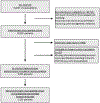Incidence of and Factors Associated With Recurrent Firearm Injury Among Patients Presenting to St. Louis Trauma Centers, 2010 to 2019 : A Cohort Study
- PMID: 37639717
- PMCID: PMC11620286
- DOI: 10.7326/M23-0069
Incidence of and Factors Associated With Recurrent Firearm Injury Among Patients Presenting to St. Louis Trauma Centers, 2010 to 2019 : A Cohort Study
Abstract
Background: Firearm injuries are a public health crisis in the United States.
Objective: To examine the incidence and factors associated with recurrent firearm injuries and death among patients presenting with an acute (index), nonfatal firearm injury.
Design: Multicenter, observational, cohort study.
Setting: Four adult and pediatric level I trauma hospitals in St. Louis, Missouri, 2010 to 2019.
Participants: Consecutive adult and pediatric patients (n = 9553) presenting to a participating hospital with a nonfatal acute firearm injury.
Measurements: Data on firearm-injured patient demographics, hospital and diagnostic information, health insurance status, and death were collected from the St. Louis Region-Wide Hospital-Based Violence Intervention Program Data Repository. The Centers for Disease Control and Prevention (CDC) Social Vulnerability Index was used to characterize the social vulnerability of the census tracts of patients' residences. Analysis included descriptive statistics and time-to-event analyses estimating the probability of experiencing a recurrent firearm injury.
Results: We identified 10 293 acutely firearm-injured patients of whom 9553 survived the injury and comprised the analytic sample. Over a median follow-up of 3.5 years (IQR, 1.5 to 6.4 years), 1155 patients experienced a recurrent firearm injury including 5 firearm suicides and 149 fatal firearm injuries. Persons experiencing recurrent firearm injury were young (25.3 ± 9.5 years), predominantly male (93%), Black (96%), and uninsured (50%), and resided in high social vulnerability regions (65%). The estimated risk for firearm reinjury was 7% at 1 year and 17% at 8 years.
Limitations: Limited data on comorbidities and patient-level social determinants of health. Inability to account for recurrent injuries presenting to nonstudy hospitals.
Conclusion: Recurrent injury and death are frequent among survivors of firearm injury, particularly among patients from socially vulnerable areas. Our findings highlight the need for interventions to prevent recurrence.
Primary funding source: Emergency Medicine Foundation-AFFIRM and Missouri Foundation for Health.
Conflict of interest statement
Figures




Similar articles
-
Factors Associated With Recurrent Pediatric Firearm Injury : A 10-Year Retrospective Cohort Analysis.Ann Intern Med. 2024 Oct;177(10):1381-1388. doi: 10.7326/M24-0430. Epub 2024 Sep 17. Ann Intern Med. 2024. PMID: 39284184 Free PMC article.
-
Defining the Full Spectrum of Pediatric Firearm Injury and Death in the United States: It is Even Worse Than We Think.Ann Surg. 2023 Jul 1;278(1):10-16. doi: 10.1097/SLA.0000000000005833. Epub 2023 Feb 24. Ann Surg. 2023. PMID: 36825500 Free PMC article.
-
Individual and neighborhood level characteristics of pediatric firearm injuries presenting at trauma centers in Colorado.J Trauma Acute Care Surg. 2022 Sep 1;93(3):385-393. doi: 10.1097/TA.0000000000003520. Epub 2022 Jan 25. J Trauma Acute Care Surg. 2022. PMID: 35998288 Review.
-
Surveillance for Violent Deaths - National Violent Death Reporting System, 48 States, the District of Columbia, and Puerto Rico, 2021.MMWR Surveill Summ. 2024 Jul 11;73(5):1-44. doi: 10.15585/mmwr.ss7305a1. MMWR Surveill Summ. 2024. PMID: 38980822 Free PMC article.
-
Pediatric Surgery Firearm Injury Collaborative Symposium.J Pediatr Surg. 2024 Jan;59(1):68-73. doi: 10.1016/j.jpedsurg.2023.09.031. Epub 2023 Sep 27. J Pediatr Surg. 2024. PMID: 37875380 Review.
Cited by
-
Machine learning classification of new firearm injury encounters in the St Louis region: 2010-2020.J Am Med Inform Assoc. 2024 Oct 1;31(10):2165-2172. doi: 10.1093/jamia/ocae173. J Am Med Inform Assoc. 2024. PMID: 38976592 Free PMC article.
-
Factors Associated With Recurrent Pediatric Firearm Injury : A 10-Year Retrospective Cohort Analysis.Ann Intern Med. 2024 Oct;177(10):1381-1388. doi: 10.7326/M24-0430. Epub 2024 Sep 17. Ann Intern Med. 2024. PMID: 39284184 Free PMC article.
-
Evaluation of a Region-Wide Hospital-Based Violence Intervention Program : A Pilot Cohort Study.Ann Intern Med. 2025 Aug;178(8):1116-1126. doi: 10.7326/ANNALS-24-01576. Epub 2025 Jul 15. Ann Intern Med. 2025. PMID: 40658952
-
Understanding the broader impacts of non-fatal firearm violence trauma in the United States: a scoping review.Lancet Reg Health Am. 2025 Apr 19;46:101091. doi: 10.1016/j.lana.2025.101091. eCollection 2025 Jun. Lancet Reg Health Am. 2025. PMID: 40290130 Free PMC article. Review.
-
Psychiatric and Substance Use Disorders After Nonfatal Firearm Injury.JAMA Psychiatry. 2025 Aug 20:e252110. doi: 10.1001/jamapsychiatry.2025.2110. Online ahead of print. JAMA Psychiatry. 2025. PMID: 40833677
References
-
- Web-based Injury Statistics Query and Reporting System (WISQARS) [online] Fatal Injury Reports, National, Regional and State, 1981 - 2020. Centers for Disease Control and Prevention, National Center for Injury Prevention and Control; 2020. https://webappa.cdc.gov/sasweb/ncipc/mortrate.html. Accessed March 21, 2022.
-
- Web-based Injury Statistics Query and Reporting System (WISQARS) [online] Leading Cuase of Death Reports, 1981-2020. Centers for Disease Control and Prevention, National Center for Injury Prevention and Control; 2020. https://www.cdc.gov/injury/wisqars/index.html. Accessed January 5, 2022.
-
- Healthy People 2020. Discrimination 2020; https://www.healthypeople.gov/2020/topicsobjectives/topic/social-determi.... Accessed December 16, 2020.
Publication types
MeSH terms
Grants and funding
LinkOut - more resources
Full Text Sources
Medical
